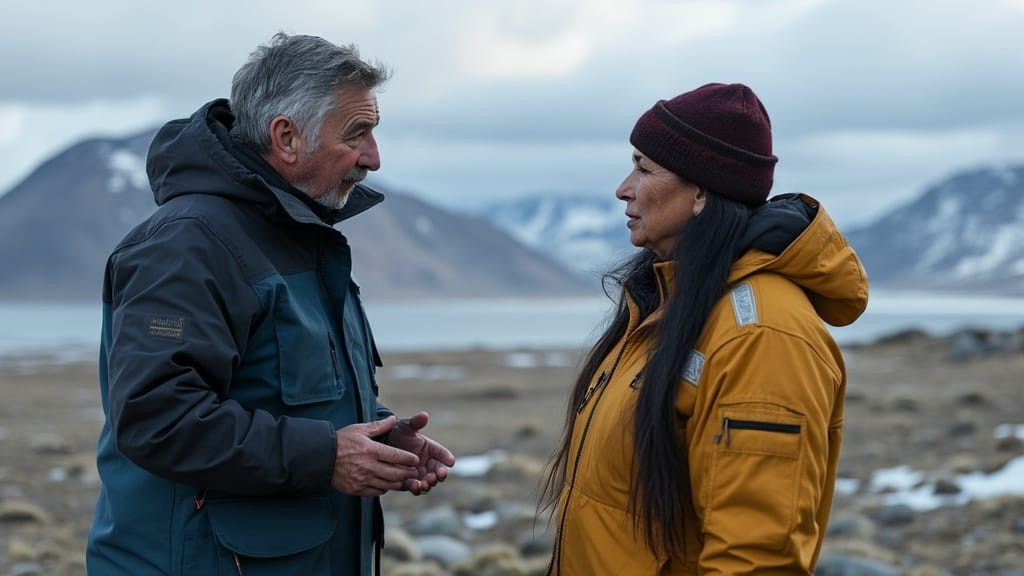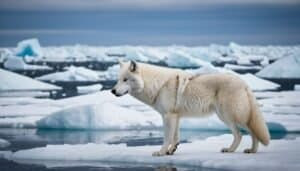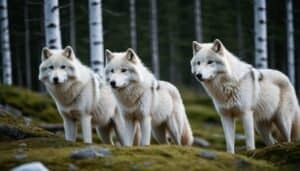Introduction
Collaboration between scientists and Indigenous communities offers a powerful approach to Arctic wolf conservation. Indigenous knowledge, built on generations of observation and interaction with Arctic ecosystems, provides valuable insights that complement scientific research
By working together, these groups can develop more effective conservation strategies that address ecological, cultural, and climatic challenges
This article explores the role of Indigenous knowledge in Arctic wolf conservation, the benefits of collaboration, and ways to overcome challenges in fostering partnerships
The Role of Indigenous Knowledge in Arctic Wolf Conservation
Indigenous communities in the Arctic have lived alongside Arctic wolves and their ecosystems for generations, developing a deep understanding of their behaviors, prey dynamics, and environmental patterns
This traditional ecological knowledge (TEK) offers unique perspectives that enhance scientific approaches to Arctic wolf conservation, especially in the context of rapidly changing climates and ecosystems
How Traditional Practices Enhance Understanding of Arctic Wolves
Indigenous communities possess intricate knowledge of Arctic wolf behavior and ecology, accumulated through centuries of close observation. This knowledge includes insights into migration patterns, hunting strategies, and seasonal behaviors that are crucial for effective conservation planning
For example, Indigenous hunters and trackers can identify subtle changes in wolf activity based on tracks, scat, and vocalizations, providing detailed information on wolf populations and their movements
Studies by Reed (2018) emphasize that Indigenous tracking techniques often surpass the precision of technological tools, especially in remote regions where scientific monitoring equipment may be sparse or impractical
Incorporating these practices into conservation strategies allows for more accurate population assessments and the identification of critical habitats for Arctic wolves
Contributions of Indigenous Knowledge to Habitat Protection
Protecting Arctic wolf habitats requires a thorough understanding of the ecosystems they depend on, and Indigenous knowledge provides valuable insights into these environments
Indigenous communities often recognize the interconnectedness of species and habitats, emphasizing the need to preserve not just the wolves but also their prey and the broader landscape
For instance, many Indigenous groups understand how caribou migration patterns affect Arctic wolf pack dynamics. This knowledge can guide conservation efforts to ensure that both predators and prey have access to the resources they need
Additionally, Indigenous land stewardship practices, such as sustainable hunting and habitat preservation, align closely with the goals of Arctic wolf conservation
Insights into Prey Dynamics and Wolf Behavior
Indigenous knowledge provides detailed observations of prey dynamics, such as changes in caribou or muskoxen populations, that directly influence Arctic wolf survival. By understanding the relationships between wolves and their prey, conservationists can design strategies that ensure balanced ecosystems
Johnson and Hanson (2021) noted that Indigenous observations of prey abundance and health often serve as early indicators of environmental stressors, such as climate change or habitat disruption
These insights enable proactive conservation measures, such as habitat restoration or prey population management, to support Arctic wolves before larger ecological imbalances occur
Benefits of Collaborative Conservation Efforts
Collaboration between scientists and Indigenous communities creates opportunities to blend traditional ecological knowledge (TEK) with scientific research
This integrated approach leads to more comprehensive conservation strategies, benefiting Arctic wolves and the ecosystems they inhabit. By building trust and leveraging complementary expertise, collaborative efforts address ecological challenges more effectively
Building Trust Between Scientists and Indigenous Communities
Building trust is a cornerstone of successful collaboration. Scientists and conservationists must recognize and respect the value of Indigenous knowledge, treating Indigenous communities as equal partners rather than mere sources of information
This involves actively engaging communities in decision-making processes and ensuring that their cultural practices and perspectives are honored
Walker (2019) highlighted that trust-building requires consistent communication, transparency, and mutual respect. Workshops, co-managed research projects, and community-led initiatives are effective ways to foster collaboration
When communities feel empowered to contribute meaningfully, conservation efforts become more inclusive and impactful
Combining Data from Research and Traditional Ecological Knowledge
The integration of scientific data and TEK provides a more holistic understanding of Arctic wolf ecology
For example, remote sensing and GPS tracking can reveal broad movement patterns, while Indigenous observations provide context about local behaviors and environmental changes. Together, these perspectives enable more precise monitoring and management of Arctic wolf populations
Spencer (2022) emphasized that combining datasets from traditional and scientific sources can identify trends that might otherwise go unnoticed
For instance, Indigenous hunters may detect changes in prey migration earlier than satellite data can, allowing conservationists to address potential food shortages for Arctic wolves proactively
Examples of Successful Partnerships in Arctic Conservation
There are several examples of successful collaborations between scientists and Indigenous communities that have benefited Arctic wolf conservation
For instance, co-management programs in Canada’s Northwest Territories involve Indigenous groups in wildlife monitoring and habitat protection efforts. These initiatives have improved the accuracy of population assessments and enhanced the effectiveness of conservation policies
Another example is the Arctic Borderlands Ecological Knowledge Co-op, which collects and shares traditional and scientific knowledge about Arctic ecosystems. This partnership has provided critical insights into predator-prey dynamics and helped guide conservation strategies for both wolves and their prey species
Such collaborations demonstrate that integrating TEK and scientific research strengthens conservation outcomes, offering a model for other regions to follow
Overcoming Challenges in Collaborative Conservation
While collaboration between scientists and Indigenous communities holds great promise, it also comes with challenges that must be addressed to ensure meaningful and effective partnerships
From respecting cultural values to addressing logistical and funding barriers, overcoming these obstacles is essential for successful Arctic wolf conservation
Respecting Indigenous Sovereignty and Cultural Values
A key challenge in collaborative conservation is ensuring that Indigenous sovereignty and cultural practices are respected
Conservation initiatives must align with the priorities and traditions of Indigenous communities, avoiding actions that may disrupt their way of life. Scientists should work closely with community leaders to design projects that reflect shared goals, rather than imposing external agendas
Johnson and Hanson (2021) stressed the importance of incorporating Indigenous governance structures into conservation efforts. For example, allowing Indigenous communities to lead monitoring programs or co-manage protected areas fosters a sense of ownership and ensures that cultural values are upheld
Additionally, agreements that explicitly recognize land rights and traditional territories help build trust and create a foundation for long-term partnerships
Addressing Barriers to Communication and Funding
Effective communication is vital for successful collaboration, but differences in language, terminology, and communication styles can create misunderstandings between scientists and Indigenous communities
Building bridges requires patience, active listening, and the use of tools such as bilingual education materials or translators when necessary
Funding is another critical challenge. Conservation projects in remote Arctic regions often require significant resources, and securing adequate funding can be difficult. Financial support is needed not only for scientific research but also for compensating Indigenous knowledge holders, providing training, and supporting community-led initiatives
Walker (2019) highlighted that government agencies, NGOs, and international organizations must prioritize funding for collaborative conservation to ensure its sustainability
Fostering Long-Term Commitment and Policy Support
Collaboration requires long-term commitment from all parties to achieve meaningful results. Short-term projects may yield valuable data but often fail to address the systemic challenges facing Arctic wolves and their habitats
Establishing long-term partnerships ensures continuity, builds stronger relationships, and allows for adaptive management as conditions change
Policy support is also essential for fostering collaboration. Governments must create legal frameworks that facilitate co-management and protect the rights of Indigenous communities
For example, policies that mandate the inclusion of Indigenous representatives in conservation decision-making processes help institutionalize collaboration and ensure that TEK is valued alongside scientific research
Conclusion
Collaboration between scientists and Indigenous communities offers a powerful approach to Arctic wolf conservation, combining traditional ecological knowledge with scientific research to address complex environmental challenges
Indigenous knowledge provides detailed insights into Arctic wolf behavior, prey dynamics, and habitat changes, while scientific methods contribute advanced tools and broader ecosystem analyses. Together, these perspectives create a more comprehensive understanding of the Arctic ecosystem
Despite the clear benefits, collaboration requires overcoming challenges such as respecting Indigenous sovereignty, ensuring equitable partnerships, and addressing logistical and funding barriers
Building trust, fostering long-term commitments, and supporting policies that prioritize co-management are essential for achieving successful outcomes
By working together, scientists and Indigenous communities can develop conservation strategies that protect Arctic wolves and their habitats while honoring the cultural and environmental values of the Arctic
These partnerships offer a model for conservation efforts worldwide, demonstrating the strength of integrating traditional and scientific knowledge to preserve biodiversity in a rapidly changing world










